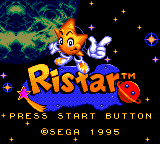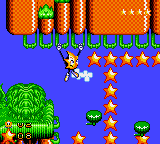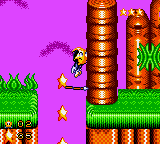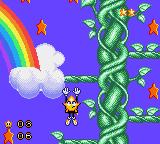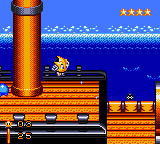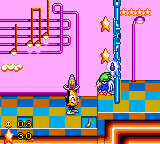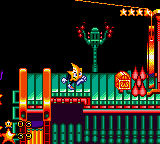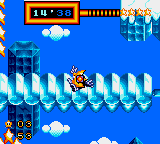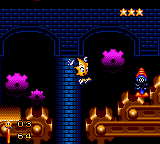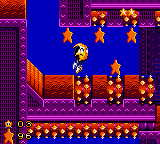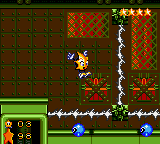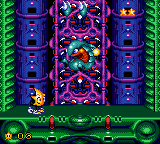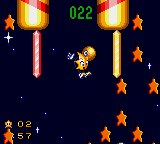Difference between revisions of "Ristar (Game Gear)"
From Sega Retro
m (→Rounds) |
|||
| Line 134: | Line 134: | ||
| title=Bonus Stages | | title=Bonus Stages | ||
| screenshot=Ristar GG BonusStage.png | | screenshot=Ristar GG BonusStage.png | ||
| − | | desc=Bonus Stages are accessed in a different manner than the Mega Drive version in that the player must collect hidden Orbs within a Round and then defeat the boss at the end of the Round. If these conditions are met, they will be transported to a Bonus Stage. | + | | desc=Bonus Stages are accessed in a different manner than the Mega Drive version in that the player must collect hidden Orbs within both areas of a Round and then defeat the boss at the end of the Round. If these conditions are met, they will be transported to a Bonus Stage. |
Whereas the Mega Drive version would task the player with getting to treasure within the time limit, the Game Gear version instead has the player bounce about in a confined arena and collect as many Big Stars as possible without falling into a pit, and will be awarded 100 points for each star they get at the end. If the player manages to collect every Big Star, they will be awarded a Perfect bonus. | Whereas the Mega Drive version would task the player with getting to treasure within the time limit, the Game Gear version instead has the player bounce about in a confined arena and collect as many Big Stars as possible without falling into a pit, and will be awarded 100 points for each star they get at the end. If the player manages to collect every Big Star, they will be awarded a Perfect bonus. | ||
Revision as of 17:16, 25 November 2020
- For the Sega Mega Drive game, see Ristar.
| Ristar | ||||||||||||||||||||||||||||||
|---|---|---|---|---|---|---|---|---|---|---|---|---|---|---|---|---|---|---|---|---|---|---|---|---|---|---|---|---|---|---|
| System(s): Sega Game Gear | ||||||||||||||||||||||||||||||
| Publisher: Sega | ||||||||||||||||||||||||||||||
| Developer: Sega CS | ||||||||||||||||||||||||||||||
| Genre: Action[1][2][3] | ||||||||||||||||||||||||||||||
| Number of players: 1 | ||||||||||||||||||||||||||||||
|
The Sega Game Gear version of Ristar, released as Ristar The Shooting Star (リスター・ザ・シューティングスター) in Japan, is a platform game released in 1995.
This 8-bit version is similar to its 16-bit counterpart on the Sega Mega Drive, but features different planets and adjusted level layouts.
Contents
Gameplay
Gameplay is pretty much identical to the Mega Drive version of Ristar, albeit scaled down to suit the Game Gear's specifications. Ristar can jump using the ![]() button, and can use his stretchy arms to grab on to enemies and headbutt them with the
button, and can use his stretchy arms to grab on to enemies and headbutt them with the ![]() button. This is the only way to eliminate enemies as jumping on them will not work. Just like in the Mega Drive version, Ristar can also use his stretchy arms to climb walls, swing around poles and even swing on Star Handles to perform a Meteor Strike. Unlike the Mega Drive version, Ristar cannot swim and will instead sink to the bottom and act like he is on land, but he can still breathe.
button. This is the only way to eliminate enemies as jumping on them will not work. Just like in the Mega Drive version, Ristar can also use his stretchy arms to climb walls, swing around poles and even swing on Star Handles to perform a Meteor Strike. Unlike the Mega Drive version, Ristar cannot swim and will instead sink to the bottom and act like he is on land, but he can still breathe.
The game uses the same health system: the player starts with 4 stars worth of health. Every time they're hit, they lose one star, but may replenish health by collecting items. Ristar also has a very basic life/continue system: once the player loses all of their lives, they'll be taken to a continue screen where they can choose to keep going with the game or give up. The password system, which was used in the Mega Drive version to enable cheats, is traditionally used to save the player's progress, and the player is given a password if they choose not to continue when they run out of lives.
Items
Some of the items listed here are exclusive to this version of the game, such as the Big Stars and the Super Star:
| Big Star[9] | |
|---|---|
| Collecting 100 of these will award the player an extra life. | |
| 1 Up[9] | |
| Awards the player an extra life. | |
| Life Star[9] | |
| Restores one star to Ristar's health. | |
| Tri-Life Star[9] | |
| Restores up to three stars to Ristar's health. | |
| Super Star[9] | |
| Makes Ristar invincible and increases his movement speed for a short while. | |
| Yellow Diamond[9] | |
| Worth 1,000, 3,000 or 5,000 points. | |
| Helmet[9] | |
| Dropped by certain enemies. Can be thrown as a projectile against other enemies. | |
| Spear[10] | |
| Dropped by certain enemies. Can be thrown as a projectile against other enemies, or against walls to act as a spring. | |
| Orb[10] | |
| Grants access to the Bonus Round after defeating the Round boss when collected. |
Rounds
Note: the level names were changed when brought to the West.
| Round 1 - Planet Flora/Neer | |
|---|---|
| Planet Flora is the first level of Ristar, and is set in a tropical island/jungle setting just like the Mega Drive version. Most of the Round is the same, except the mini-boss in the first area has been replaced with a wall of glass blocks to break through, and the second area will require Ristar to use spears to overcome trees. Riho remains in place as the boss of Flora, and is just as easy to defeat. | |
| Round 2 - Planet Terra/Fanturn | |
| The second Round replaces Planets Undertow and Scorch with a completely different planet that serves as a very large oddity. It is a dream-themed world that has the player go through a sky-themed area with fluffy clouds, rainbows and beanstalks to climb, and an area set on a pirate ship with masts to climb up and hooks to swing down on. For whatever reason, the first area of this Round has been dummied out in the Western releases, stripping the planet down to one area and the boss, but it can still be accessed by cheating.
The boss is a tapir-like creature who heals himself by sleeping and altering the world around him. The player has to first take out the bat that covers his lantern so he cannot sleep, then throw his pillows back at him. Defeating him causes the world to transform into a decrepit nightmare. | |
| Round 3 - Planet Sonata/Neuos | |
| With the absence of Planet Scorch in this version of the game, Planet Sonata is now the third Round. Like with Flora, Sonata is much like its 16-bit counterpart, complete with having to deliver metronomes to songbirds in order to proceed. Both of its bosses are intact, though the mini-boss has one less mechanical head to deal with due to the smaller screen. | |
| Round 4 - Planet Freon/Timu | |
| The second Game Gear-exclusive Round is also an oddity in that its first area is an ice level similar to the 16-bit game's Planet Freon, albeit with time-themed decorations, and even has the same name in the Western versions. The second area, however, is very different as the player will navigate a large clock tower.
The central gimmick of this Round is the presence of timed gates throughout both areas. When Ristar passes through one of them, a time bomb will be stuck to him, and the player must rush to a pool of water to get the bomb off Ristar before time runs out. The boss is a rabbit fought inside an hourglass, who will attack by either bouncing on Ristar or stopping time to shoot projectiles from his belly. | |
| Round 5 - Planet Automaton/Rewope | |
| Planet Automaton is the third planet to be ported from the Mega Drive version and is the fifth Round of this game. Most of it is the same as in the Mega Drive version, except the anti-gravity section in the first area has had its anti-gravity gimmick removed, and the mini-boss is replaced with a cluster of Big Stars for the player to grab. Uranim is fought in the same way as the Mega Drive version. | |
| Round 6 - Planet Greedy | |
| Castle Greedy holds the final fights against Inonis and Greedy just like in the 16-bit version, however the first section is different in that the player must ride an elevator and defeat a shower of enemies, with Adahan (the boss of the 16-bit version's Planet Scorch) making a surprise appearance as a mini-boss. | |
| Bonus Stages | |
| Bonus Stages are accessed in a different manner than the Mega Drive version in that the player must collect hidden Orbs within both areas of a Round and then defeat the boss at the end of the Round. If these conditions are met, they will be transported to a Bonus Stage.
Whereas the Mega Drive version would task the player with getting to treasure within the time limit, the Game Gear version instead has the player bounce about in a confined arena and collect as many Big Stars as possible without falling into a pit, and will be awarded 100 points for each star they get at the end. If the player manages to collect every Big Star, they will be awarded a Perfect bonus. |
Versions
Localised names
| Language | Localised Name | English Translation |
|---|---|---|
| English | Ristar | Ristar |
| English (US) | Ristar | Ristar |
| Japanese | リスター・ザ・シューティングスター | Ristar The Shooting Star |
Production credits
- Game Planner: Nencoo Gutoku
- System Programmer: Alice Kagamino
- Ristar Programmer: Mika Muraoka
- Boss Programmer: Haruo Nakajima
- Enemy Programmer: Ezachan
- Effect Programmer: Masami Tezuka
- Demo Programmer: Hanamogera.D
- Character Designer: Francis.N, Pixy Monty
- Planet Designer: Mauo.S, General Kusumi
- Music Composer: LKJ.Chikayo, Tomoko Sasaki
- Sound Programmer: Kazune Hiiragi
- Project Director: Capt.Jinguji
- Art Director: Nencoo Gutoku
- Lead Tester: Matt Underwood
- Assistant Lead Testers: Carey Camacho, David Dodge
- Special Thanks to: Nag, Bryan.M, Wadachi, Tarachan, Chikyuchan, Tamachan, Nana Kusunoki, Ristar MD Staff and Genesis Staff
- Producer: Rhonda Van
- Assistant Producer: Erik Wahlberg
- Marketing: Chrissy Huneke Kremer
- Presented by: ©Sega 1995
Magazine articles
- Main article: Ristar (Game Gear)/Magazine articles.
Promotional material
also published in:
- GamePro (US) #68: "March 1995" (1995-xx-xx)[11]
- Sega Visions (US) #24: "May 1995" (1995-xx-xx)[12]
Artwork
Physical scans
| Sega Retro Average | |||||||||||||||||||||||||||||||||||||||||||||||||||||||||||||||||||||||||||||||||||||||||||||||||||||||||||||
|---|---|---|---|---|---|---|---|---|---|---|---|---|---|---|---|---|---|---|---|---|---|---|---|---|---|---|---|---|---|---|---|---|---|---|---|---|---|---|---|---|---|---|---|---|---|---|---|---|---|---|---|---|---|---|---|---|---|---|---|---|---|---|---|---|---|---|---|---|---|---|---|---|---|---|---|---|---|---|---|---|---|---|---|---|---|---|---|---|---|---|---|---|---|---|---|---|---|---|---|---|---|---|---|---|---|---|---|---|---|
|
| 81 | |
|---|---|
| Based on 21 reviews | |
Technical information
ROM dump status
| System | Hash | Size | Build Date | Source | Comments | |||||||||
|---|---|---|---|---|---|---|---|---|---|---|---|---|---|---|
| ✔ |
|
512kB | Cartridge | |||||||||||
| ? |
|
512kB | 1994-09-09 | CD-R disc | Page | |||||||||
| ? |
|
512kB | 1994-10-19 | CD-R disc | Page | |||||||||
| ? |
|
512kB | 1994-10-24 | CD-R disc | Page | |||||||||
| ? |
|
512kB | 1994-11-01 | CD-R disc | Page | |||||||||
| ? |
|
512kB | 1994-11-02 | CD-R disc | Page |
References
- ↑ File:Ristar GG EU Box Back.jpg
- ↑ File:Ristar gg jp box.jpg
- ↑ 3.0 3.1 https://sega.jp/history/hard/gamegear/software.html (Wayback Machine: 2018-12-07 04:57)
- ↑ Electronic Gaming Monthly, "January 1995" (US; 199x-xx-xx), page 266
- ↑ 5.0 5.1 GamePro, "March 1995" (US; 1995-xx-xx), page 125
- ↑ 6.0 6.1 6.2 6.3 6.4 Mean Machines Sega, "March 1995" (UK; 1995-01-30), page 86
- ↑ 7.0 7.1 7.2 Sega Magazine, "February 1995" (UK; 1995-01-15), page 88
- ↑ Games World Magazin, "" (DE; 1995-02-17), page 20
- ↑ 9.0 9.1 9.2 9.3 9.4 9.5 9.6 File:Ristar GG US Manual.pdf, page 7
- ↑ 10.0 10.1 File:Ristar GG US Manual.pdf, page 8
- ↑ GamePro, "March 1995" (US; 1995-xx-xx), page 9
- ↑ Sega Visions, "May 1995" (US; 1995-xx-xx), page 51
- ↑ 13.0 13.1 Consoles +, "Février 1995" (FR; 1995-0x-xx), page 106
- ↑ Player One, "Février 1995" (FR; 1995-0x-xx), page 102 (100)
- ↑ Electronic Gaming Monthly, "February 1995" (US; 199x-xx-xx), page 36
- ↑ Electronic Gaming Monthly, "March 1995" (US; 1995-0x-xx), page 38
- ↑ Famitsu, "1995-02-24" (JP; 1995-02-10), page 39
- ↑ Freak, "5/95" (IL; 1995-xx-xx), page 1
- ↑ Game Players, "Vol. 8 No. 5 May 1995" (US; 1995-0x-xx), page 63
- ↑ Games World: The Magazine, "March 1995" (UK; 1995-01-26), page 20
- ↑ Game Informer, "February 1995" (US; 1995-0x-xx), page 60
- ↑ Hobby Consolas, "Marzo 1995" (ES; 1995-xx-xx), page 104
- ↑ Mega Fun, "03/95" (DE; 1995-02-22), page 76
- ↑ Mega Play, "February/March 1995" (US; 1995-0x-xx), page 49
- ↑ Player One, "Février 1995" (FR; 1995-0x-xx), page 102
- ↑ Play Time, "4/95" (DE; 1995-03-08), page 106
- ↑ Sega Power, "April 1995" (UK; 1995-02-16), page 65
- ↑ Sega Pro, "February 1995" (UK; 1994-12-29), page 49
- ↑ Sega Saturn Magazine, "March 1995" (JP; 1995-02-08), page 132
- ↑ Todo Sega, "Marzo 1995" (ES; 1995-0x-xx), page 51
- ↑ Video Games, "3/95" (DE; 1995-02-23), page 109
| Ristar (Game Gear) | |
|---|---|
|
Main page | Comparisons | Maps | Credits | Hidden content | Development | Magazine articles | Reception | |
- 1 player games
- JP Game Gear games
- All JP games
- US Game Gear games
- All US games
- EU Game Gear games
- All EU games
- DE Game Gear games
- All DE games
- UK Game Gear games
- All UK games
- Game Gear games
- 1995 Game Gear games
- All 1995 games
- Game Gear action games
- All action games
- All games
- Credits without source
- Credits without reference
- Old-style rating (consolesplus)
- Old-style rating (egm)
- Rating without source
- Old-style rating (gameplayers)
- Old-style rating (gamesworld)
- Rating without PDF source
- Old-style rating (mms)
- Old-style rating (playerone)
- Old-style rating (segamaguk)
- Old-style rating (segapower)
- Old-style rating (segapro)
- Update ratings template
- 9 old ratings
- Games with known prototypes
- Old technical information
- Ristar (Game Gear)
